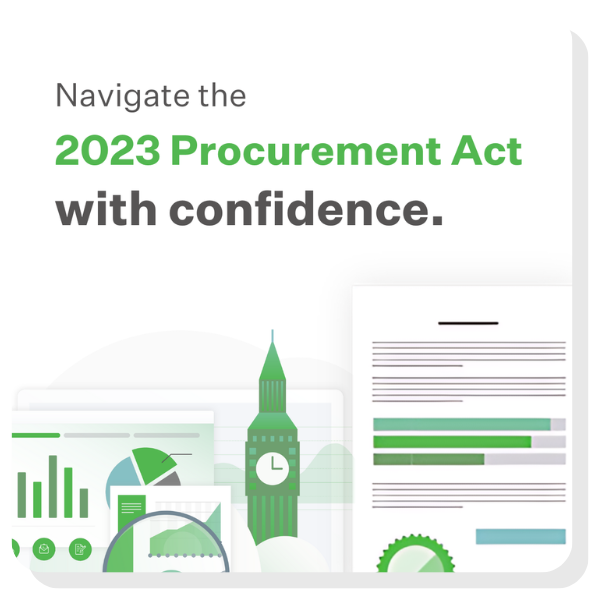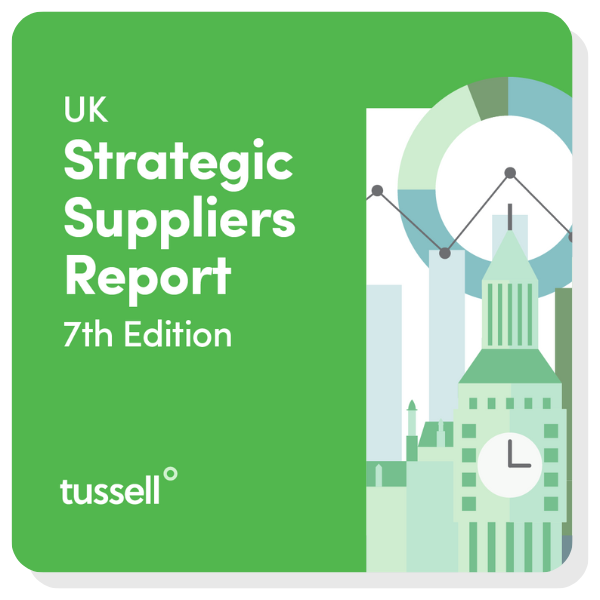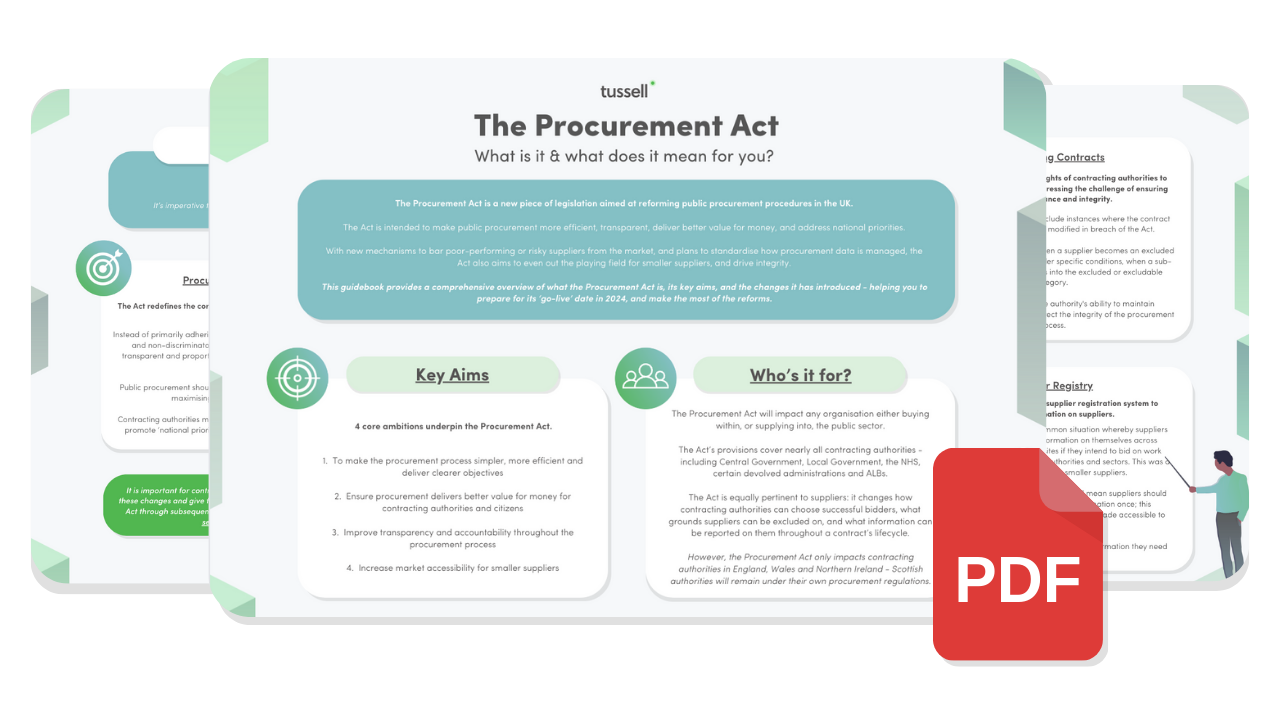Common Procurement Vocabulary (CPV) codes were introduced into EU and UK procurement in 2006 to help with contract, tender and framework categorisation.
Almost two decades - and one Brexit - later, the UK public sector still uses CPV codes to sort public sector contracts.
But what are CPV codes? How are they used? And how have they been affected by the 2023 Procurement Act?
Read on to learn everything you need to know about Common Procurement Vocabulary, or skip ahead to read about:
- What are CPV codes?
- How are CPV codes used?
- How should suppliers use CPV codes?
- How should buyers use CPV codes?
- How does the Procurement Act affect CPV codes?
🔢 What are CPV codes?
Common Procurement Vocabulary (CPV) codes are eight/nine digit codes used by public sector buyers to categorise contracts, tenders, pre-tender notices, framework agreements and Dynamic Markets.
You'll find them when browsing online tender portals or when using public sector market intelligence platforms like Tussell.
The first two digits of the code identify the core division of a contract or procurement. For example, CPV codes beginning with 72 all relate to IT services.
From there, each subsequent digit represents a deeper level of categorisation.
The third digit of the code identifies the group, the forth digit of the code identifies the class, the fifth represents the category, and the final digits represent the item.
-1.png?width=450&height=383&name=Soft%20FM%20contract%20example-%20CPV%20code%20blog%20(2)-1.png)
When used to their full effect, CPV codes allow public sector buyers to be extremely specific about the services they've procured or are procuring.
However, in reality, CPV codes can rarely used in such a precise manner. Therefore, suppliers to government should be careful when using insights derived from CPV code categorisation to inform strategy.
🔎 How are CPV codes used?
When publishing contract notices, tender notices, pre-tender notices, framework agreements and Dynamic Markets, public sector buyers are required to pick one or more CPV codes that reflect the nature of the contract or opportunity in question.
This simple categorisation method is intended to improve transparency and provide consistent classification to enable would be public sector suppliers to more easily find tenders in their sector.
However, in reality, CPV codes have several limitation that detrimentally impact their usability.
📜 In the case of large contracts
When procuring several services together - as is often the case in the facilities management sector - knowing which CPV codes to choose can be tough.
Contracting authorities will often opt for a scattergun approach, selecting any potentially relevant CPV codes to avoid being missed by potential suppliers.
Take for example one £280 million tender notice published by an unnamed NHS Trust in November 2024 where the procurement officer tagged the tender with 14 CPV codes, including 98000000 (other community, social and personal services), 55524000 (school catering services), and 72253000 (help desk and support services).
The contract was actually for hospital facilities management ...
Funeral directors, dog kennel providers and hairdressers would have all seen this contract in online portals when using the 98000000 code to search for opportunities in their niche.
Imagine scrolling endlessly for tenders in your sector and finding that most of the opportunities are large contracts in sectors you don't operate in!
Now imagine trying to conduct market sizing or account planning using the results of your CPV code search.... It's just not possible.
📜 In the case of small contracts
In contrast to some large tenders and contracts which are tagged with too many CPV codes, many small contracts are tagged with too few.
Take for example one £30k contract between a supplier and an unnamed City Council for alternative learning provisions for young people. In this case, the procurement officer tagged the contract with the 85000000 CPV code (health & social services).
Any alternative learning provider would have completely missed this contract if they used the education CPV code - 80000000 - as the basis for their search.
💼 How should suppliers use CPV codes?
In an ideal world CPV codes would be a silver bullet for finding contracts and tenders in your sector.
In the real world, Tussell recommends using CPV codes in conjunction with other search criteria when using tender portals or market analysis tools to get a full view of your market.
We urge suppliers to build tender and contract search queries using a combination of broad high-level CPV codes and key words and phrases.
In fact, when searching in Tussell's market intelligence platform, we only allow users to select CPV codes at the division, group and class level. That's because refining a CPV code search beyond this point almost always results in a profound distortion of the market.
When searching for contracts or tenders it is recommended that you build out a query using as many relevant keywords as possible so that nothing slips through the gaps.
Suppliers may also wish to filter by framework agreement, contract value, buyer, supplier, date, location or value to zoom in on a particular area of the market.
Unfortunately, if you're using Find a Tender, much of this search functionality won't be available.
However, if you're using Tussell, your dedicated public sector market specialist will work with you to build out searches that capture every relevant tender, framework and contract in your market.
🏛️ How should buyers use CPV codes?
Getting your tenders in front of suppliers is difficult - especially given the limitations of CPV codes we've already covered in this article.
The cynical solution to the problem of classification is to select as many CPV codes as possible to increase the visibility of your tender notices. But if everyone did this, the whole system would become redundant.
NHS England requires contracting authorities to use the most specific CPV code they can, rather than an overarching one.
Contracts and tenders tagged with highly specified CPV codes can still be found by suppliers that use broad CPV codes in their searches.
When procuring multi-sector contracts, the UK Government recommend that contracting authorities use multiple CPV codes to categorise notices.
Tussell also suggests that contracting authorities use relevant keywords in tender, framework and contract notice titles and descriptions to make notices more visible across tender portals and Tussell's market intelligence platform.
📜 How does the Procurement Act affect CPV codes?
The 2023 Procurement Act is set to revolutionise public sector procurement. However, CPV codes will be unaffected by the new legislation.
Access Tussell's Procurement Act Hub for free resources and explainers to help you procure better or do more business with government when the Procurement Act goes live.
Concerned about how the Procurement Act will affect your company or procurement team? You're not alone!
Book a demo with the Tussell team to learn how you can use Tussell to make smarter procurement decisions and/or de-risk your public sector sales strategy.
Tussell's market intelligence platform is already used by top public sector contracting authorities and over two thirds of the UK Government strategic suppliers. Don't miss out. Book a demo today.
🌅 Conclusion
CPV codes aren't perfect, but that doesn't mean they still can't be a useful tool for finding and categorising public sector contracts.
When sizing your market or tracking new opportunities, you just need to know how to wield them in combination with other search criteria.
If you want to learn more about how you can use CPV codes to find tenders and better understand your market, book a call with the Tussell team for a demo of the Tussell platform.












.png?width=815&height=200&name=TUSSELL_Demo_CTA_Banners%20(1).png)

.png?width=815&height=200&name=TUSSELL_Demo_CTA_Banners%20(6).png)


